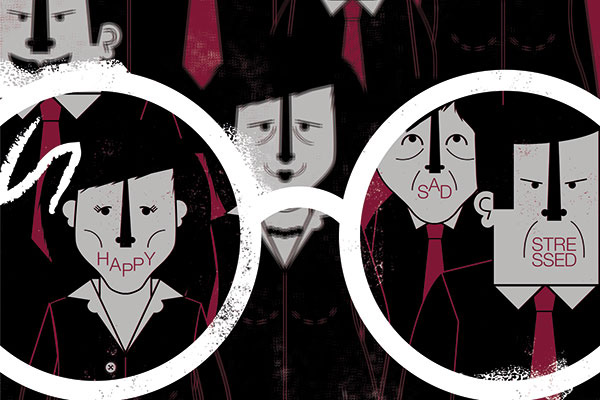By Kerrie Fleming | 05 September 2013
Public finance teams are under more pressure than ever before. There are more challenges from around the organisation, as everyone needs to absorb increased workloads in the face of reduced staff. All of this underlines the importance of emotional intelligence to help motivate teams

We experience many types of emotions in our daily lives, such as fear, anger, enjoyment, disgust, interest, surprise, contempt, shame, sadness and guilt. These emotions become much stronger during times when our values and beliefs are compromised by ourselves or others. However, in order to function professionally, we often have to temporarily manage these emotions to encourage smooth communication or to avoid conflict in the moment.
But managing these emotions does not equate to ignoring them, since, over time, this can take its toll and lead to stress, with true personal feelings leaking through the mask.
One concept that may help with this is emotional intelligence (EI). In 1995, Daniel Goleman described EI as: knowing how one is feeling and being able to handle those feelings without becoming swamped; being able to motivate oneself to get jobs done; being creative and performing at one’s peak; sensing what others are feeling and handling relationships effectively.
Sounds great, but how can we develop emotional intelligence? Are you born with it, or can you learn some strategies to develop it?
Developing EI is all about being self-aware and aware of others. This involves lifting your head from the task in hand and noticing what is going on around you. It is about how you deal with problems – leading by example, taking the initiative, handling difficult situations, and developing good relationships with colleagues and clients. EI is a powerful means of communicating effectively, building relationships and creating a positive working environment.
The reality is that some people are better than others at reading their own emotions and those of others. Like everything, once you know what to look for, you can practise and start to pay close attention to some key signals and cues that are all around you.
Here are ten top tips on how to develop your EI to get more from yourself and those you work with.
Listen to your own emotions
They are offering you some very important data on your instinctive feelings about people and situations, and will give you some real clues as to whether the person or situation is making you feel a certain way. This information will allow you to assess whether this person or situation is possibly in conflict with your values or beliefs. This process of naming the feeling may reduce an impulse-led reaction against them or the situation.
Pay attention to how others are feeling
Sometimes when handling a task, we are focused on how we are feeling, but we may be causing uncomfortable emotions in the person we are communicating with. Be alert to clues in body language, including facial expression, stance, gestures and tone. For example,
a simple physical movement may indicate that someone is withdrawing from a conversation, because it may no longer have relevance for them or you may have said something they disagree with. Don’t plough on – ask open questions to gauge whether you are still engaging them or not.
Notice moods
Observe how some people make you feel more energised than others. Why do you think that is? Do you share similar values or beliefs? If so, you can leverage this good mood
and bring it to your next meeting, which will allow you to create a positive mood in others around you. Good moods are contagious, as are bad moods! Don’t underestimate the power of your mood at work, as this can affect whether people want to work with you or not.
What is behind the emotion?
When you meet someone expressing an emotional response, such as being angry or sad, think about what may be behind this before you react. This can be difficult if it is aimed at you, but most of the time, it is not about you. Sometimes when people feel inadequate, or out of control, they react emotionally if they think their beliefs are being compromised. An emotionally intelligent person will not react to the emotion, but will take the time to find out what is really going on.
Managing our emotions
We all notice that some people and situations make us feel better or worse than others. Sometimes we have no choice but to work with people who are very different to us and who evoke strong reactions from us. It is important not to ignore these feelings, but manage them in a way that works.
If you feel angry or upset in a situation where it would be inappropriate to display such emotions, work out some strategies to channel that emotion into a safe, effective outlet. This may involve removing yourself from the situation to go for a walk outside for some fresh air.
Promote wellbeing
An open culture where there is an ongoing dialogue with staff, and where people feel valued and involved, is the bedrock of a mentally healthy workplace. There needs to be a clear message from the top that it’s OK to say so if you’re not coping, and team leaders need to support sensible working hours and expect staff to take lunch breaks.
Focus on strengths
Psychologist Sarah Lewis advocates helping your team understand their strengths. ‘The more you can help people use their strengths at work, the more likely it is they will become self-motivated,’ she says.
Invest in learning
Make investment in learning and development a priority. If people feel properly equipped to do their jobs, they are more likely to feel happy in their work and capable of coping with the challenges that are thrown at them. It’s not just about equipping people with technical or specialist skills, it’s also about helping them to develop the techniques to manage their workload and cope with any setbacks. Activities that can help might include ‘lunch and learn’ sessions or small-action learning groups where people can help each other work through professional challenges.
Foster an open atmosphere
Teams work best in an environment where feedback is encouraged and issues are shared openly. It’s important to listen to your team when they tell you things are not working as well as they should be – and also to encourage them to listen to each other. Make sure you create a supportive environment where any concerns or problems can be raised ‘safely’ and where everyone pulls together to find a solution.
Paint the big picture
If people are clear about where they are headed, they are more likely to contribute and take an active part in the journey. If they don’t understand the overall goal, they may prioritise the wrong things, argue with colleagues over the right course of action, or cause resentment by unwittingly treading on other people’s territory. Make sure everyone understands the overall objectives and direction, and has a clear idea about how to get there. People are much more likely to pull together and be happy at work when they have a sense of ‘shared’ purpose, and are on the same page as the rest of their colleagues.
DO
1. Be alert to your own feelings and those of others
2. Learn to manage emotions
3. Promote an open culture
DON'T
1. Plough on talking if others withdraw
2. Take others’ emotions personally
3. Express emotions inappropriately
Kerrie Fleming is director of the Ashridge Leadership Centre at Ashridge Business School, specialising in leadership development, with particular expertise in emotional intelligence
This feature was first published in the September edition of Public Finance magazine




















